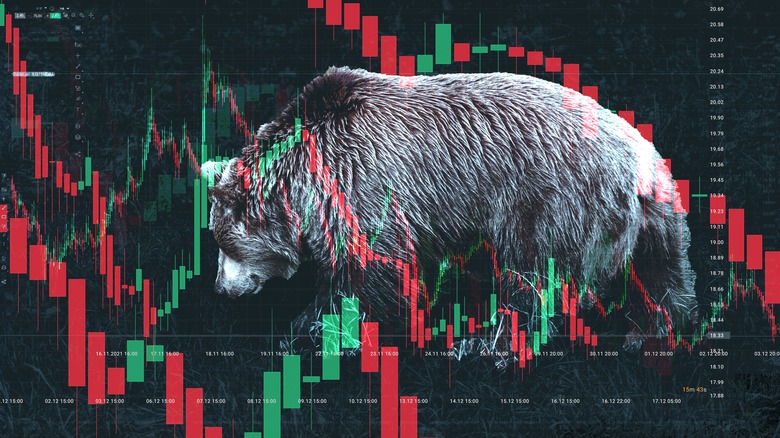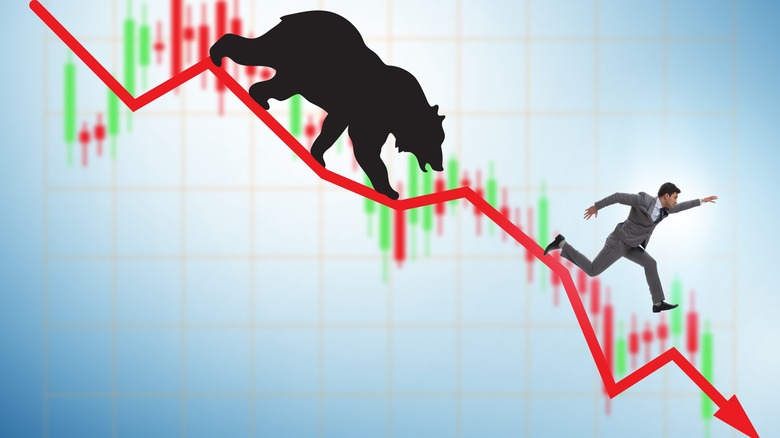Bear Markets: Facts You Need To Know
A bear market triggers nightmares for many investors. Bear markets are those that are experiencing an elongated downward trend — with a threshold of decline marked by a 20% price decrease off of the most recent high mark, according to the World Economic Forum.
A bear market can be scary for those who haven't experienced depressed economic and financial outlooks before — particularly when it comes to savings portfolios designed to support retirement or large, future purchases like a home or a child's college education. Yet, bear market conditions aren't something that spells complete disaster for individuals within their designation as an investor or consumer. In fact, bear markets offer a plethora of opportunities to gain traction in the savings arena.
Bear markets provide rock-bottom pricing on wonderful growth assets, for one thing. As the market contracts, so too do the price of everything from steady earners like REITs to explosive tech stocks like the FAANG collection that has often dominated stock market conversations among friends. A correction (reduction of pricing by 10%) or bear territory can be dizzying, frightening, and confusing all at once. But with a knowledgeable approach to the new market conditions at play, maintaining balance and preparing for the future doesn't have to be any of those things.
A bear market form as commodity prices rise above sustainable levels (sometimes)
Bear market conditions occur when markets are overheated and pricing becomes unsustainable, leading to a corrective period. The thing that sets a bear market apart from simple price correction lies in the social, political, and economic atmosphere beyond the commodity marketplace itself.
Market conditions are in a constant state of fluctuation. Prices ebb and flow, and they continue on in a generally upward trajectory across the marketplace, in line with typical inflation and commercial growth patterns. The stock market averages a historical annualized uptick of about 10%, but individual traders can dramatically outperform the market or languish in nearly static movement or even negative growth across each individual year (or the long term). Over a 15-year period, only about 10% of investment funds that are actively managed are able to outperform the market itself.
The drive to continually deliver increasing profits plays a big role in the negative price movements throughout the market. While individual investors, financial planners, and institutional investment managers are constantly trying to maneuver their assets into a position of consistent, prime earnings, so too are companies working to place their brands at the forefront. The trick for investors is to maintain calm and make intelligent and knowledgeable decisions that work best for the marketplace and the individual investor. Weathering the storm is all about patience and faith in the market's ability to course correct.
Intense competition and a drive for ever-increasing profits lead to collapses
This hypercharged level of competition for increasingly slim margins leads to competitive overheating, and an inevitable course correction eventually settles over a company, sector, or the entire market. Often, these corrective periods last a short span while investors reshuffle their portfolios and brands shore up in-house financial considerations. Then, the market returns to the familiar and steady upward price movement that dominates much of the historical charts' visualizations.
Occasionally, there is a perfect storm of conditions that exist beyond the marketplace or corporate world that can upend commercial and consumer finances, sending the market reeling. Since 1947, there have been 26 instances of bear market conditions, with economic recession and stock market decline being limited but often notable. Some of the most significant downturns in recent memory have come while oil prices were suddenly slashed, during the housing market and mortgage crisis, the dot-com bubble implosion, and most recently, alongside economic shuttering as a result of the coronavirus pandemic.
Competition leads businesses to continually seek areas in which they can expand operations and exhibit new levels of control. In one immediately consequential sense, the true customer of a publicly listed company is the shareholder, not the consumer who frequents the brand's physical or digital storefronts. This leads to a prioritization of profits over all else, which can, at the worst of times, foment economic destabilization and induce drastic downward pressure into the marketplace.
Bear markets create insecurity, instability, and financial stress in the near term
A bear market's most pressing issue lies in the inability to sell. Selling at a loss is one of the most unfavorable outcomes in all of investing and commodity trading. Investors must constantly be on their toes throughout the entirety of a bear market because opportunity can be fleeting, and the window to act small. Investing during depressed economic conditions is tough, and often forces investors to inject more cash into their portfolios rather than working with funding that's already in place. This can lead to intense financial stress as savings goals and budgeting needs rub up against one another.
The desire (and financial need, in instances from retirement planning to saving for a new home) to continue experiencing positive growth within a portfolio can lead to key areas of overextension when it comes to managing finances, and this, coupled with the stress of a market that's seemingly in freefall, can become overwhelming in a hurry.
Insecurity, instability, and stress are all common themes during a bear market, but these feelings of chaos can be mitigated with a strong long-term strategy. Buying for the future is the first thing that investors in a bear market should consider. To support this approach, it's important to think about how much you can realistically set aside for long-term savings. Spending cuts and prioritizing savings in the budget can help make this a more attainable reality.
Savings efforts are critically important during bear markets
When writing up your budget and perusing your family's finances, savings is often placed as an afterthought. But working it up near the top can help you make room for consistent or even increased contributions with ease. Budgeting for the mortgage or rent payment, electricity, TV and internet, insurance and car payments, and then your savings (ahead of eating out at restaurants or the purchase of new accessories for the entertainment room, car, or toolshed, for instance) can give this expenditure the weight it deserves.
Indeed, saving is an expenditure, and treating it in this manner allows you to truly invest in your future without having to work it into the plan each week or month. A typical consumer should try to budget 10% of their income to the expense of long-term savings each month.
Because these conditions happen so frequently, all investors must have a plan to hedge the downward price pressure that is imposed on assets, and an existing and well-developed savings strategy is the first line of defense when it comes to maximizing your strengths during this time of economic weakness. Whether your strategy is a buy-and-hold approach or a more aggressive day trading option designed to capitalize on the more volatile price structure that often dominates bear markets, preparing for this financial certainty before it happens is a must for all investors.
Bear markets don't last forever
The most important thing to remember during bear markets is that they don't last forever. Similarly, the length of recent bear market recoveries has often significantly outpaced the number of months that the market was in bear territory to begin (via Hartford Funds). A bear market is calamitous in the short term, but for those who are able to stick it out, the results can actually be much more favorable than continued upward price momentum. If you're able to increase or keep steady the amount of capital you are bringing into your investment portfolio each month during corrections or bear markets, your spending power is magnified by a huge margin.
From 2007 to 2009, the housing market collapse and oil price uncertainty sparked a bear market, sending stock prices careened downward by 51%, while the dot-com bubble knocked stocks down 45% for over two years. Importantly, both of these recent periods of supremely negative price movement came to an end, and stocks rebounded substantially in the years that followed.
Because stocks are pieces of companies that exist in the real world, bear markets simply cannot last forever. Consumers rely on brands to produce and make available products and services. Barring a catastrophic event that fundamentally alters the way people exist, commercial trading will always remain. All this adds up to a vibrant trading environment that will continue to see substantial downturns alongside elongated periods of growth.
New short-term strategies can be employed
Bear markets create a hazard for investors in the cash flow department. Selling to liquidate buying power is often off the table because of depressed realized profit figures on any sale (with some even falling into negative territory). This means that cash reserves need to be found in other ways. Prioritizing free cash is crucial to unlocking fast movement potential. Adding as much additional cash to your investment account as you can will help deliver on this need, but it's important to remember that anything you save should be kept as savings. Working to keep budgeted savings and cash for purchases divorced from one another is crucial to investing in both bear and bull markets alike.
Investing with the knowledge that stocks will return to positive movement means that an investor must jump on the temporarily reduced pricing that occurs during these conditions when the opportunity arises. Merrill Lynch notes that emotional or knee-jerk decision-making is a great way to lose money during bear market conditions. Instead, it's essential to prioritize well-considered planning and strategy sessions throughout your investment periods. Traders may not come back to the market to place new orders on a daily basis, but whenever you do revisit the marketplace, take stock of the current situation and always make decisions with the current and future conditions as a guide rather than any emotion you might bring to the table.
Older investors lean on price stability while young investors double down on pricing collapse
For older investors, a bear market can deal a heavy blow, but for younger traders, it signals a great opportunity for immense growth. Older investors will want to consider their needs over the longer term, because invested cash often acts as a kind of salary to cover bills and living expenses. It may be worthwhile to move cash out of any assets that have yet to see substantial losses. Another option is to push resources into stable dividend creators that have shown elasticity in payouts through other bear markets. This can give you better longevity as you work to elongate the reach and viability of your retirement assets.
For younger investors, buying growth stocks at strategic price points (on their downward path) is a must. It may be worthwhile to consider a more aggressive pattern of quasi-day trading, but by and large the most important thing to do during a bear market is buy for the long term. Blue chip company stocks (companies like Google, Home Depot, Nike, Coca-Cola, Visa, or Microsoft) exhibit some of the greatest corporate staying power in the modern world. These brands will continue to thrive long after a bear market recedes, which means that a purchase while the price is down 20% or more from its most recent high will more than likely reward a strategic buyer in a sizable way.
Bear markets occur every 3.6 years, on average
On average, a bear market occurs every 3.6 years, according to Hartford Funds. While the latest bear conditions happened after a very long break from economic uncertainty, the inevitable truth is that the market will cycle through immense prosperity and devastating collapses time and again. All investors will eventually see a turn toward bear conditions and must understand how to deal with these layers of strain and uncertainty.
One thing that can help is a strategically diversified portfolio. In typical bear conditions, healthcare, food, utilities, and consumer staples remain viable options to maintain stability. This is naturally a result of the fact that people need to get to work, eat, see their doctor, and more, regardless of where the economy or stock market is headed. Similarly, investments in bullion, real estate, or other alternative commodity assets can help hedge the pain of bear market retraction.
Get Money Rich notes that equity assets and gold or other precious metal holdings typically exhibit an inverse relationship, meaning a bear market for stock investors signals growth in pricing for bullion and coin collections. However, it should be noted that bullion is far more difficult to sell than stocks because it must be physically moved, and often appraised before a deal can be struck. On the other hand, one share of a company is exactly the same as another, and through online brokerage accounts, an investor can buy or sell assets nearly instantaneously.
Long vision is essential to seeing this period through
Long vision is crucial for investors. This isn't just the ability to keep focused on the fact that the market will recover. Rather, long vision helps an investor make decisions about who might come out ahead when the market does eventually return to its more typical pattern of upward momentum.
During times of financial squeezing, some smaller companies will inevitably close up shop or become absorbed by larger corporate entities looking to close in on a new territory, product, or capability. These changes in the dynamic makeup of the marketplace can really transform the way that investors view and purchase shares of any particular company. Similarly, a solid acquisition can lead to increased consumer demand that threatens existing or new competitors in a market space.
It's become almost cliché, but some of the best advice for working through a bear market is to follow Warren Buffett's reading habit. Buffett spends an exorbitant amount of time reading and thinking. This gives him the ability to collect and collate information that might seem irrelevant, but is highly useful when recalled in light of new and evolving facts.
With more time spent reading and thinking, Buffett says that he is better able to judge opportunities on their merit, rather than his own emotional response. Simply put, thinking about the market helps you develop long vision. This gives you greater confidence in seeing patterns that will help time purchases.









